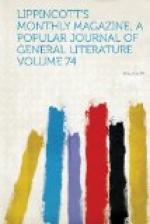To gain a fair idea of the popularity of the library one should spend a mid-winter Saturday afternoon and evening with the librarian and his busy assistants. Early in the afternoon numbers of young ladies leave the shopping and fashionable thoroughfares up-town and throng the library-room. The attendants, all young men, work with increased animation under the stimulus. Books fly from counter to alcoves and return, messenger-boys dart hither and thither, the fair patrons thumb the catalogues and chatter in sad defiance of the rules. They are long in making their selections, and appeal for aid to the librarians. But the last of this class of visitors departs before the six-o’clock dinner or tea, and the attendants have a respite for an hour. At seven the real rush begins, with the advent of the clerks and other patrons employed in store or office during the day, each intent on supplying himself with reading-matter for the next day. From this hour until the closing at nine the librarians are as busy as bees: there is a continual running from counter to alcove and from gallery to gallery. In some of the reports of the librarian interesting data are given of the tastes of readers and the popularity of books. Fiction, as we have seen, leads; but there is a growing taste for scientific and historical works. Buckle, Mill, and Macaulay are favorites, and Tyndall, Huxley, and Lubbock have many readers. The theft of its books is a serious drain on the library each year, but the destruction of its rare and valuable works of reference is still more provoking. Common gratitude, it might seem, would deter persons admitted to the privileges of its alcoves from injuring its




